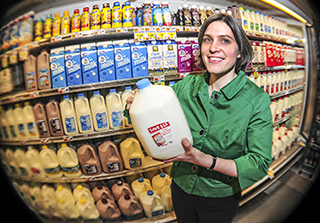UAlbany Historian Takes a Fresh Look at Milk
ALBANY, N.Y. (February 26, 2014) -- The granddaughter of a Midwestern dairy farmer, Kendra Smith-Howard spent her summers scooping ice cream cones for Uncle Bob’s Homemade Ice Cream. But as a college student, she pursued greater adventures – working as a park ranger in Montana’s Glacier National Park, and teaching and studying in places as far away as Indonesia.
 |
|
Professor Kendra Smith-Howard, in the dairy aisle of a local Price Chopper, looks at the history of milk in new and surprising ways. (Photo by Mark Schmidt) |
It was during that time -- halfway around the world and investigating rural development -- that Smith-Howard began, unexpectedly, to be curious about places like the area where she grew up. How had changes in agriculture reshaped the landscape of America’s small towns and rural areas? What did these changes mean for rural people?
Ultimately, she applied some of her curiosity to the study of a substance as seemingly ordinary as the small town where she grew up: milk.
Smith-Howard, Department of History, has written an engaging new book Pure and Modern Milk: An Environmental History Since 1900 (Oxford University Press) that shows the evolution of this quintessentially American product. While we associate milk with wholesomeness, purity and rural tranquility, the reality is quite a bit more complex.
An environmental historian, Smith-Howard’s research examines the intersection among consumer culture, agriculture, and public health.
Why study milk?
“I was particularly drawn to the everyday, quotidian relationships between people and nature – things like the foods on which we rely daily,” she said. “Milk is unique – it is a staple food, and one whose very material form posed challenges to its widespread use. It’s also tightly tied to our cultural notions about childhood and the pastoral in the U.S.,” she said.
Smith-Howard wanted to give voice to the very difficult challenges and paradoxes that not only face eaters (as has been highlighted by books like Michael Pollan’s Omnivore’s Dilemma) but also farm producers. She wanted to help people understand how and why farm people made the choices they did over the course of the 20th century to make farming more technology-dependent, energy-intensive, and large-scale.
“So much of the contemporary critique of the agricultural system pits organic vs. conventional, big vs. small that it’s hard to understand why changes to the agricultural system ever seemed like a good idea in the first place,” she said. “Putting these decisions in historical context helps make sense of how we arrived at the present agricultural order. It also makes clear that the ends of the spectrum that are so often posed as clear choices have more in common than one might think.”
Today’s workers who sit in front of a computer all day might long for the fresh air and wholesome life of running their own dairy farm. Smith-Howard gives us a reality check: “There’s not much attention to the ceaseless requirements of milking twice a day, 24/7. And the glistening images of pastoral environments on the milk carton don’t come accompanied by the stench of manure.”
For a product that is synonymous with natural, Smith-Howard points out that it requires a lot of intervention to turn cow’s milk into the milk you pour on your cereal. Farmers worked to level the production of milk throughout the year, altering its natural cycle of more milk in the late spring and summer when pastures were lush and less in the winter. Other changes make milk more artificial: breeding cows to produce more milk, or storing grass to be fed as silage rather than on pasture.
Additional findings Smith-Howard offers in her book, include:
· Milk was once considered “too natural.” Milk spoiled, it could contain dirt and disease. Drinking it could make the person who drank it ill, or for many babies in the summertime – even die.
· Prior to World War II, skim milk was considered to be “hog slop,” and was fed to farm animals as a way to save money on animal feed.
· In the 1920s, the streams in rural areas with cheese factories and creameries were clogged with stinking dairy discharge. With the advent of the automobile, the stench from rotting whey and skim milk left untreated in rural streams was not conducive to tourism.
· Scientists found ways to turn milk by-products into household goods, including casein, used to coat airplane wings in WWI, as glue in wood-working, and even hardened into plastic to make buttons or combs. For a time this “milk wool” was used to replace fur in hats and upholster car seats.
“A central message of my book is that milk never stops being a product of nature, nor is it free of technological intervention. Rather, milk is both a natural product of cows and a product of human culture and technologies,” said Smith-Howard.
Her research for the book was supported with grants from the Smithsonian Institution’s National Museum of American History, the Virginia Historical Society, and at UAlbany through the Nuala McGann Drescher Affirmative Action/Diversity Leave Award from United University Professions.
Smith-Howard earned a Ph.D. in history at the University of Wisconsin-Madison before joining the UAlbany history faculty in 2007.
![]() For more news, subscribe to UAlbany's RSS headline feeds
For more news, subscribe to UAlbany's RSS headline feeds
A comprehensive public research university, the University at Albany-SUNY offers more than 120 undergraduate majors and minors and 125 master's, doctoral and graduate certificate programs. UAlbany is a leader among all New York State colleges and universities in such diverse fields as atmospheric and environmental sciences, business, education, public health,health sciences, criminal justice, emergency preparedness, engineering and applied sciences, informatics, public administration, social welfare and sociology, taught by an extensive roster of faculty experts. It also offers expanded academic and research opportunities for students through an affiliation with Albany Law School. With a curriculum enhanced by 600 study-abroad opportunities, UAlbany launches great careers.


